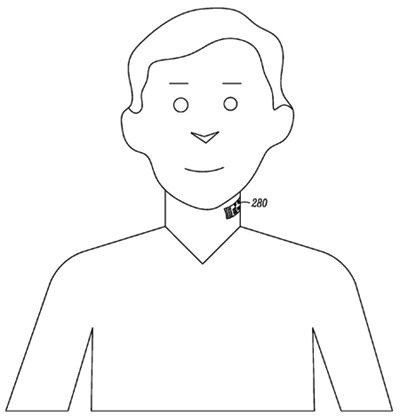Science Fiction
Dictionary
A B C D E F G H I J K L M N O P Q R S T U V W X Y Z
Google's Skin Tattoo Lie Detector

Google's Motorola division has filed a patent for a microphone with lie-detector circuitry directly onto your throat. Take a look at the amazingly detailed picture below, taken from the patent application "Coupling an Electronic Skin Tattoo to a Mobile Device".

(Coupling an Electronic Skin Tattoo to a Mobile Device)
As the filing explains, in noisy environments it's often difficult to carry on a clear conversation using a mobile phone. A way to cut down on background noise would be a welcome development, and a microphone plastered on your throat, picking up your voice directly, makes sense.The device in question could also be configured to transmit commands to your phone, also useful in a noisy environment and when one's hands are full. Power for the device could be supplied by a variety of methods, including "solar panel technology, capacitive technology, nanotechnology, or electro-mechanical technology."
"Optionally," the filing muses, "the electronic skin tattoo can further include a galvanic skin response detector to detect skin resistance of a user. It is contemplated that a user that may be nervous or engaging in speaking falsehoods may exhibit different galvanic skin response than a more confident, truth telling individual."
First, I'd like to point out that the idea of an electronic tattoo has been around for a while in science fiction. Consider the hand writer from John Varley's 1984 novel Steel Beach. I'd also mention Jack Vance's spray-on conductive film from his 1979 story The Face.
And don't forget about the palm flower from the 1967 novel Logan's Run.
The earliest mention of an implantable device like Google's lie detector tattoo is probably the emotional registers from Brian Aldiss' 1961 novel The Primal Urge. It describes the device as a small metal disk implanted in the forehead, which glows pink when the wearer is feeling sexual attraction.
All, in fact, he told himself, sighing, alarmingly ordinary. "Oh ye of the average everything," he addressed himself, improvising, as he frequently did, a rhymed oration, "Oh, ye of the average height, overtaken by taller folk, undertaken by smaller folk… an average fate one might certainly call a joke."One feature only was definitely not, as yet all events, ordinary: the shining circle. Three and a half centimetres in diameter, permanently fixed in the centre of his forehead. Made of a metal resembling stainless steel, its surface was slightly convex, so that it gave a vague and distorted image of the world before it.
(Read more about Brian Aldiss' emotion register (ER))
The most accurate predictor of an electronic tattoo in science fiction was probably the subdermal microchannels from Paul Di Filippo's 1985 story Stone Lives.
Via The Register; thanks to icecycle for contributing the reference story and the sfnal ancestor.
Scroll down for more stories in the same category. (Story submitted 11/19/2013)
Follow this kind of news @Technovelgy.| Email | RSS | Blog It | Stumble | del.icio.us | Digg | Reddit |
Would
you like to contribute a story tip?
It's easy:
Get the URL of the story, and the related sf author, and add
it here.
Comment/Join discussion ( 0 )
Related News Stories - (" Surveillance ")
LingYuan Vehicle Roof Drones Now Available, ala Blade Runner 2049
Accompanied by a small selection of similar ideas from science fiction.
Chameleon Personalized Privacy Protection Mask
'...the Virtual Epiphantic Identity Lustre.' - Neal Stephenson, 2019.
Spherical Police Robot Rolls In China
'Rand could effectively be in several places at once...' - Niven and Pournelle, 1981.
Vietnam To Have Full Biometric Transparency
'inscriptions too small to be seen with the naked eye; microscopic data...' - Eric Frank Russell, 1939.
Technovelgy (that's tech-novel-gee!) is devoted to the creative science inventions and ideas of sf authors. Look for the Invention Category that interests you, the Glossary, the Invention Timeline, or see what's New.
Science Fiction
Timeline
1600-1899
1900-1939
1940's 1950's
1960's 1970's
1980's 1990's
2000's 2010's
Current News
Natural Gait With Prosthetic Connected To Nervous System
'The leg was to function, in a way, as a servo-mechanism operated by Larry’s brain...'
Woman Marries Computer, Vonnegut's Dream Comes True
'Men are made of protoplasm... Lasts forever.'
Spidery 'Walk Me' Toyota Autonomous Wheel Chair Like Star Wars
Walk along with the emperor.
Dancing Robots Taught Dance Moves
'A clockwork figure would be the thing for you...'
Proof Of Robothood - Not A Person
'Who are you people? - Show 'em.'
Indonesian Clans Battle
'The observation vehicle was of that peculiar variety used in conveying a large number of people across rough terrain.'
The 'Last Mile' In China Crowded With Delivery Robots
Yes, it's a delivery robot. On wheels.
Tornyol Microdrone Kills Mosquitoes
'The real border was defended by... a swarm of quasi-independent aerostats.'
PLATO Spacecraft, Hunter Of Habitable Planets, Now Ready
'I ... set my automatic astronomical instruments to searching for a habitable planet.'
Factory Humanoid Robots Built By Humanoid Robots
'...haven't you a section of the factory where only robot labor is employed?'
iPhone Air Fulfils Jobs' Promise From 2007 - A Giant Screen!
'... oblongs were all over the floor and surfaces.'
ChatGPT Now Participates in Group Chats
'...the city was their laboratory in human psychology.'
iPhone Pocket All Sold Out!
'A long, strong, slender net...'
Did The Yautja Have These First?
What a marvel of ingenuity the little device was!
Jetson ONE Air Races Begin, Can Air Polo Be Far Behind?
'If you're one of those rarities who haven't attended a rocket-polo "carnage", let me tell you it's a colorful affair.'
Will Space Stations Have Large Interior Spaces Again?
'They filed clumsily into the battleroom, like children in a swimming pool for the first time, clinging to the handholds along the side.'
